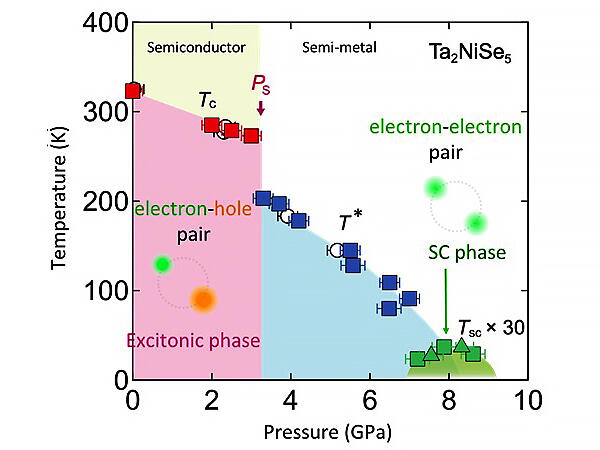The research group led by Associate Professor Kazuyuki Matsubayashi of the University of Electro-Communications, Graduate School of Informatics and Engineering, conducted precise physical property measurements of Ta2NiSe5, which is a promising candidate as an excitonic insulator, at gigapascal-level high pressure, thereby succeeding in creating a comprehensive phase diagram from the low-pressure semiconductor phase to the high-pressure semimetal phase.
In recent years, in the layered transition-metal chalcogenide Ta2NiSe5 that exists in a state near the semiconductor-semimetal boundary, characteristic band structure changes and electronic phase diagrams suggesting that the material is an exciton insulator have been reported and are attracting attention worldwide. However, because the phase transition to the excitonic phase in Ta2NiSe5 involves a structural change, it has been indicated that both electron-hole and electron lattice interactions play an important role, and the controversy over the origin of the phase transition is still ongoing.
The research group measured Ta2NiSe5 using precise physical properties at gigapascal-level high pressure and observed that a unique insulator, which is in a condensed state of electron-hole pairs, transforms to a superconductor, which is in a condensed state of electron coupling, at high pressures.
The results of this research showed that there were various quantum condensed phases in which electron-hole interactions and electron-lattice interactions were combined in the boundary region between a semiconductor and a semimetal. This development is expected to be a guideline for future material development. In addition to high pressure, attempts to control the excitonic phase using laser light and a strong magnetic field and the development of materials with a structure similar to that of Ta2NiSe5 have been reported, and further research is expected in the future. This research result was published in the July issue of the English journal, Journal of the Physical Society of Japan (JPSJ).

Credit: Kazuyuki Matsubayashi
Associate Professor Matsubayashi said, "In the vicinity of the boundary region where semiconductors change to metals, we were able to show that there are various quantum condensed phases in which Coulomb interactions acting between charged particles are intricately combined. It will be a new guideline for the future development of superconducting materials and the control of quantum condensed phases."
This article has been translated by JST with permission from The Science News Ltd.(https://sci-news.co.jp/). Unauthorized reproduction of the article and photographs is prohibited.




